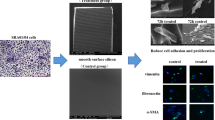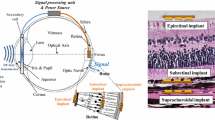Abstract
Background
Implantation of silicone materials like iris diaphragms into the eye can be complicated by cell migration and attachment. We studied polydimethylsiloxane (PDMS) foils coated with isocyanate terminated, star-shaped poly(ethylene glycol-stat-propylene glycol) (NCO-sP(EO-stat-PO)) equipped with heparin towards the inhibition of cell attachment without influencing cell viability.
Methods
Mouse fibroblasts L929 were cultured and seeded onto sterilized pieces of either uncoated NCO-sP(EO-stat-PO) or heparin-NCO-sP(EO-stat-PO) loaded foils. Polyvinylchloride (PVC) foils served as the positive control and biomembranes as the negative control. The cultured cells were examined after 24 h for cell viability and adhesion by fluorescence microscopy; morphological cell changes were documented after hemalaun staining. Cell density was measured and quantification of cell proliferation was assessed by a BrdU test; quantification of cell activity was analyzed by a WST-1 test.
Results
The fibroblasts’ cell viability was excellent on all tested foils except the toxic PVC foil. NCO-sP(EO-stat-PO) coating provided significantly reduced cell activity. On heparin-loaded coatings, cells were viable and less dense but showed almost the same cell proliferation and cell activity as on the negative control. NCO-sP(EO-stat-PO) coated, heparin loaded foils proved high biocompatibility and reduced cell adhesion.
Conclusions
Both NCO-sP(EO-stat-PO)-coated foils with and without heparin seemed to be a viable implantation material for less cell migration, attachment, and reduced implant complications. Conclusive we give a recommendation for further studies on the intraocular implantation in particular for the NCO-sP(EO-stat-PO)-coated foils.





Similar content being viewed by others
References
Ratner BD (2004) A history of biomaterials. In: Hoffman AS, Schoen FJ, Lemons JE (eds) Biomaterials Science—An Introduction to Materials in Medicine, 2nd edn. Academic Press, San Diego, pp 10–19
Wintermantel E, Ha SW (2008) Medizintechnik- Life Science Engineering. Springer, Berlin Heidelberg New York, pp 50–61
Szurman P, Bartz-Schmidt KU (2000) Silicone oils in retinal surgery. Ophthalmologe 97:514–525
Cibis PA, Becker B, Okun E, Canaan S (1962) The use of liquid silicone in retinal detachment surgery. Arch Ophthalmol 68:590–599
Brash JL (2000) Exploiting the current paradigm of blood-material interactions for the rational design of blood-compatible materials. J Biomater Sci Polym Ed 11:1135–1146
Bartzoka V, McDermott MR, Brook MA (1999) Protein silicone interactions. Adv Mater 11:257–259
Groll J (2004) Specific and Directed Biomolecular Recognition on Star PEG Coatings. Verlag Mainz, Aachen 8:109–110
Groll J, Ameringer T, Spatz JP, Möller M (2005) Ultrathin Coatings from Isocyanate-Terminated Star PEG Prepolymers: Layer Formation and Characterization. Langmuir 21:1991–1999
Groll J, Ademovic Z, Ameringer T, Klee D, Möller M (2005) Comparison of Coatings from Reactive Star Shaped PEG-stat-PPG Prepolymers and Grafted Linear PEG for Biological and Medical Applications. Biomacromolecules 6:956–962
Kvach JT, Veras JR (1982) A fluorescent staining procedure for determining the viability of mycobacterial cells. Int J Lepr Other Mycobact Dis 50(2):183–189
Montdargent B, Letourneur D (2000) Toward new biomaterials. Infect Control Hosp Epidemiol 21:404–410
Bartzoka V, McDermott MR, Brook MA (1999) Protein silicone interactions. Adv Mater 112:57–259
Amon M, Menapace R (1994) In vivo documentation of cellular reactions on lens surfaces for assessing the biocompatibility of different intraocular implants. Eye Lond, 8:649–656
Larsson R, Selen G, Bjordklund H, Fagerholm P (1989) PMMA lenses modified with surface-immobilized heparin: evaluation of biocompatibility in vitro and in vivo. Biomaterials 10:511–516
Chen H, Chen Y, Sheardown H, Brook MA (2005) Immobilization of heparin on a silicone surface through a heterobifunctional PEG spacer. Biomaterials 26:7418–7424
Dick B, Greiner K, Magdowski G, Pfeiffer N (1997) Long-term stability of heparin-coated PMMA intraocular lenses. Results of an in vitro study. Ophthalmologe 94(12):920–924
Heimann K, Konen W (1992) Artificial iris diaphragm and silicone oil surgery. Retina Philadelphia Pa 12:S90–S94
Thumann G, Kirchhof B, Bartz-Schmidt KU, Jonescu-Cuypers CP, Esser P, Konen W, Heimann K (1997) The artificial iris diaphragm for vitreoretinal silicone oil surgery. Retina Philadelphia Pa 17:330–337
Keller GK, Dahlke C, Kuckelkorn R, Schrage N (2003) Experience with the artificial iris diaphragm in hypotonic eyes. Ophthalmologe 100:203–208
Acknowledgements
The technical assistance of this research project by the Interdisciplinary Centre for Clinical research "BIOMAT" within the Faculty of Medicine at the RWTH Aachen University is gratefully appreciated.
Supported by a grant (TV-B109) from the Interdisciplinary Centre for Clinical Research "BIOMAT" within the faculty of Medicine at the RWTH Aachen University and a grant by the START program of the medical faculty of the RWTH Aachen University.
Financial relationship
None.
Author information
Authors and Affiliations
Corresponding author
Rights and permissions
About this article
Cite this article
Fischer, S., Carstesen, D., Klee, D. et al. Surface-modified silicone foils for intraocular implantation. Graefes Arch Clin Exp Ophthalmol 250, 823–827 (2012). https://doi.org/10.1007/s00417-012-1956-1
Received:
Revised:
Accepted:
Published:
Issue Date:
DOI: https://doi.org/10.1007/s00417-012-1956-1




